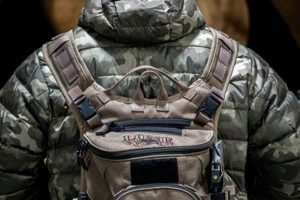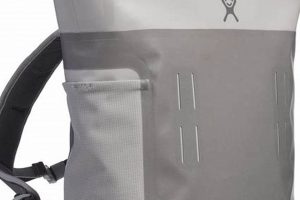The query addresses the feasibility of cleaning a rucksack or similar carrying bag by machine washing and drying. The implicit question concerns whether this method is safe for the bag and effective in removing dirt and grime. For example, an individual might inquire if a school backpack laden with daily use debris can withstand a washing machine cycle and subsequent tumble drying.
Understanding the proper care instructions for bags offers several advantages. It can extend the lifespan of the item, preventing premature wear and tear that might result from improper cleaning methods. Furthermore, appropriate cleaning can maintain the bag’s appearance and functionality, ensuring it remains a useful and presentable accessory. Historically, individuals relied on manual cleaning techniques for bags, but the advent of modern appliances has raised questions about the viability of machine washing and drying.
The following discussion delves into the potential effects of machine washing and drying on various backpack materials and construction types. It will outline precautions to take if this method is deemed appropriate and suggest alternative cleaning methods for bags that are unsuitable for machine cleaning.
Tips for Addressing the Feasibility of Machine Washing and Drying Backpacks
This section provides essential advice regarding the practice of cleaning backpacks via washing machines and dryers. It focuses on mitigating potential damage and maximizing cleaning efficacy.
Tip 1: Examine the Care Label: The manufacturer’s label provides critical information regarding appropriate cleaning methods. Adherence to these instructions minimizes the risk of damage.
Tip 2: Empty All Pockets: Thoroughly inspect and empty all pockets. Leaving items inside can damage both the bag and the washing machine. Pay particular attention to pens, which can leak ink, and electronics, which can be ruined by water.
Tip 3: Protect Delicate Components: Mesh pockets, straps, and decorative elements can be vulnerable to damage. Place the backpack inside a mesh laundry bag or pillowcase to provide protection during the wash cycle.
Tip 4: Use a Gentle Cycle and Mild Detergent: Opt for a delicate wash cycle with cold water. Employ a mild, bleach-free detergent to prevent discoloration or material degradation.
Tip 5: Avoid the Dryer Whenever Possible: High heat from a dryer can shrink or warp the fabric and damage hardware. Air drying is the preferred method. If the dryer is necessary, use the lowest heat setting.
Tip 6: Reshape and Air Dry: After washing, reshape the backpack to its original form and allow it to air dry completely. Avoid direct sunlight, which can fade colors.
Tip 7: Inspect Hardware After Drying: Once dry, check zippers, buckles, and other hardware components for any signs of damage or corrosion. Lubricate zippers if necessary.
Following these guidelines can significantly reduce the risk of damaging a backpack during machine washing and drying, while still achieving a satisfactory level of cleanliness.
The final section will address alternative cleaning methods and offer a concluding perspective on the appropriate care for backpacks.
1. Material Compatibility
Material compatibility is paramount when considering machine washing and drying a backpack. The type of fabric used in its construction dictates its suitability for these cleaning methods. Incompatibility can result in damage, shrinkage, or degradation of the backpack’s material.
- Water Resistance and Absorption
Certain materials, like nylon and polyester, inherently possess water resistance. However, prolonged exposure to water during machine washing can compromise coatings designed to enhance this resistance. Conversely, materials like cotton absorb significant amounts of water, increasing drying time and the risk of mildew if not dried thoroughly. The material’s interaction with water directly influences the outcome of the washing process.
- Heat Sensitivity
Many synthetic fabrics are susceptible to heat damage. High temperatures during tumble drying can cause shrinkage, warping, or even melting in some instances. For example, a backpack with a PVC coating could become sticky or deformed under high heat. Identifying the fabric’s heat tolerance is crucial before subjecting it to the dryer.
- Colorfastness
The dye used to color the backpack’s fabric may not be colorfast. Machine washing, especially with warm water, can cause the dye to bleed, resulting in discoloration or staining of other parts of the backpack. Prior testing of a small, inconspicuous area can help determine the dye’s stability.
- Structural Integrity
Washing and drying can weaken the fibers of certain materials, particularly natural ones like cotton or canvas. Repeated machine cycles can lead to fraying, tearing, or overall weakening of the fabric’s structure, reducing the backpack’s durability. This is particularly relevant for backpacks subjected to frequent cleaning.
In summary, the material composition of a backpack is a primary factor in determining its suitability for machine washing and drying. Assessing the fabric’s water resistance, heat sensitivity, colorfastness, and structural integrity is essential to prevent damage and maintain the backpack’s functional lifespan. Understanding these properties, consulting the care label, and opting for gentle cleaning methods significantly increase the likelihood of a successful outcome.
2. Hardware Durability
The hardware components of a backpack, such as zippers, buckles, and metal fasteners, are integral to its functionality. The durability of this hardware directly influences whether a backpack can withstand the stresses of machine washing and drying. Failure to consider hardware durability can lead to damage, compromising the backpack’s usability.
- Zipper Integrity
Zippers are often the weakest point of a backpack’s hardware. The repeated agitation and exposure to water and heat during machine washing can cause zipper teeth to become misaligned or broken. Metal zippers may corrode, while plastic zippers may warp or crack. A compromised zipper renders a compartment unusable. Backpacks with reinforced or heavy-duty zippers are more likely to withstand machine cleaning.
- Buckle Resilience
Buckles, typically made of plastic, are used to secure straps and closures. Machine washing and drying can subject buckles to significant stress. Low-quality plastic buckles can become brittle and break under pressure, particularly when exposed to heat. Higher-grade plastic or metal buckles are more resilient and less prone to damage during machine cleaning.
- Metal Fastener Corrosion
Metal rivets, snaps, and other fasteners are used to reinforce stress points on a backpack. Exposure to water can cause these fasteners to corrode, weakening their structure and potentially staining the surrounding fabric. Saltwater exposure, especially, accelerates corrosion. Backpacks with stainless steel or rust-resistant metal fasteners are less susceptible to this issue.
- Strap Attachment Strength
The points where straps attach to the backpack body are critical load-bearing areas. Machine washing and drying can strain these attachment points, particularly if the backpack is heavily loaded during the wash cycle. Weakened stitching or damaged fasteners can lead to strap detachment, rendering the backpack unusable. Backpacks with reinforced stitching and durable attachment hardware are better suited for machine cleaning.
In conclusion, the hardware durability of a backpack is a significant factor in determining its suitability for machine washing and drying. Assess the quality and material of zippers, buckles, and fasteners, and consider the strength of strap attachments before subjecting the backpack to these cleaning methods. Damage to these components can severely impact the backpack’s functionality and lifespan. Choosing backpacks with robust hardware and employing gentle cleaning techniques mitigates the risk of damage during machine cleaning.
3. Detergent Type
The selection of detergent is a critical factor when considering machine washing a backpack. The chemical properties of the detergent can directly influence the integrity and appearance of the backpack’s materials. Inappropriate detergent choices can lead to irreversible damage, negating any perceived benefits of machine cleaning.
- pH Level and Fabric Compatibility
Detergents possess varying pH levels, ranging from acidic to alkaline. Highly alkaline detergents can degrade certain synthetic fabrics, such as nylon and polyester, causing them to lose strength and durability. Likewise, some dyes are sensitive to pH extremes, leading to fading or discoloration. Neutral pH detergents are generally recommended for backpacks constructed from a variety of materials. For instance, washing a backpack with a canvas exterior and nylon lining requires a detergent mild enough to preserve both materials. Using a harsh detergent could weaken the canvas fibers and damage the nylon lining simultaneously.
- Bleaching Agents and Color Preservation
Many detergents contain bleaching agents, such as chlorine bleach or optical brighteners, designed to enhance whiteness or color vibrancy. However, these agents can also cause significant color fading or discoloration, particularly on colored or patterned backpacks. Chlorine bleach is especially harsh and can permanently damage certain fabrics. Using a color-safe detergent without bleaching agents is essential to preserve the backpack’s original appearance. An example includes a backpack with intricate embroidery; a bleaching agent could fade the thread colors, ruining the design.
- Enzymes and Material Degradation
Enzymatic detergents contain enzymes that break down stains from organic matter, such as food, grass, and sweat. While effective for stain removal, these enzymes can also degrade natural fibers, such as cotton and linen, over time. Repeated washing with enzymatic detergents can weaken these materials, reducing the backpack’s lifespan. For example, a cotton canvas backpack regularly subjected to enzymatic detergents might exhibit premature wear and tear, such as fraying and tearing.
- Residue and Water Repellency
Certain detergents leave behind a residue on the fabric after washing, even after rinsing. This residue can attract dirt and grime, making the backpack appear dirty more quickly. Additionally, detergent residue can interfere with the water-repellent properties of treated fabrics, diminishing their ability to resist moisture. A backpack designed to be water-resistant may lose this functionality if washed with a detergent that leaves a significant residue. Choosing a detergent specifically formulated to rinse cleanly is crucial for maintaining both the appearance and performance of the backpack.
In summary, the choice of detergent significantly impacts the outcome of machine washing a backpack. Selecting a detergent with a neutral pH, free of bleaching agents and harsh enzymes, and formulated to rinse cleanly is essential to minimize the risk of damage and maintain the backpack’s appearance and functionality. These considerations are critical for ensuring that attempting to clean the backpack does not inadvertently lead to its premature deterioration.
4. Temperature Settings
Temperature settings during machine washing and drying are critical determinants of a backpack’s structural integrity and aesthetic appeal. Inappropriate temperatures can lead to irreversible damage, shrinking, or degradation of materials, ultimately rendering the cleaning process counterproductive.
- Warm Water and Dye Stability
Warm water, while often effective for stain removal, can accelerate dye bleeding in certain fabrics. This is particularly relevant for backpacks with vibrant colors or intricate patterns. The elevated temperature increases the kinetic energy of dye molecules, causing them to leach from the fabric and potentially stain other areas of the backpack or other items in the wash. Selecting a cold water setting minimizes this risk, preserving the backpack’s original coloration. For example, a backpack with red and white stripes may experience significant color bleeding if washed in warm water, resulting in pink staining of the white stripes.
- Hot Water and Material Shrinkage
Hot water can induce significant shrinkage in natural fibers, such as cotton and linen, and even some synthetic blends. The heat causes the fibers to contract, leading to a reduction in the backpack’s overall size and potentially altering its shape. This shrinkage can compromise the backpack’s fit and functionality, particularly if it contains rigid components or structured compartments. Avoiding hot water settings is crucial for maintaining the backpack’s original dimensions. Imagine a backpack with a padded laptop compartment: shrinkage could render the compartment too small to accommodate the laptop.
- High Heat Drying and Fabric Melting
High heat settings in a tumble dryer can cause melting or warping of synthetic materials, such as nylon and polyester. These materials are thermoplastic, meaning they soften and deform when exposed to high temperatures. Excessive heat can also weaken the fabric’s fibers, making them more susceptible to tearing. Air drying is the preferred method, but if a dryer is used, it should be set to the lowest possible heat setting or a no-heat setting. A backpack with PVC coating could easily melt or become sticky if subjected to high heat in a dryer.
- Cold Water and Cleaning Efficacy
While cold water is generally safer for backpacks, it may be less effective at removing certain types of stains, such as grease or oil-based stains. Pre-treating these stains with a specialized stain remover before washing in cold water can improve cleaning efficacy without risking damage from higher temperatures. A backpack used for carrying lunch may accumulate grease stains, which would require pre-treatment before a cold water wash to ensure effective stain removal.
In summary, careful consideration of temperature settings is essential when attempting to machine wash and dry a backpack. Selecting appropriate temperatures based on the backpack’s materials and construction minimizes the risk of damage, discoloration, or shrinkage, ensuring that the cleaning process effectively removes dirt and grime without compromising the backpack’s integrity.
5. Drying Method
The drying method employed after washing a backpack significantly impacts its overall condition and longevity. Improper drying techniques can negate the benefits of careful washing, leading to damage and reduced functionality. Consequently, selecting an appropriate drying method is integral to assessing whether a backpack can be successfully machine washed.
- Tumble Drying and Heat Exposure
Tumble drying, particularly with high heat settings, poses a substantial risk to backpack materials. Synthetic fabrics commonly used in backpack construction, such as nylon and polyester, are susceptible to melting, warping, or shrinkage when exposed to elevated temperatures. The tumbling action can also stress seams and hardware. A backpack with a waterproof coating may lose its protective layer due to the heat. Thus, tumble drying should be avoided unless explicitly permitted by the manufacturer’s care instructions.
- Air Drying and Ventilation
Air drying is generally the preferred method for drying backpacks after washing. It minimizes the risk of heat damage and allows the backpack to dry gradually. However, proper ventilation is crucial to prevent the growth of mold and mildew, particularly in enclosed compartments or padded areas. A well-ventilated space promotes efficient evaporation, reducing the drying time and minimizing the risk of bacterial growth. Ensuring adequate airflow is essential for successful air drying.
- Direct Sunlight and Color Fading
While direct sunlight can accelerate drying, prolonged exposure can cause fading of colors, particularly in brightly colored or patterned backpacks. Ultraviolet (UV) radiation in sunlight can break down the chemical bonds in dyes, leading to a gradual loss of color intensity. Placing the backpack in a shaded area with good ventilation allows for effective drying without the risk of color fading. Protecting the backpack from direct sunlight preserves its aesthetic appearance.
- Forced Air Drying and Material Stress
Forced air drying, using fans or dehumidifiers, can expedite the drying process. However, excessive forced air can stress the backpack’s materials, particularly if it is not adequately supported. Concentrated airflow can warp the shape of the backpack or weaken seams. Distributing airflow evenly and supporting the backpack’s structure during forced air drying minimizes the risk of damage. Judicious use of forced air can be a safe and effective drying method.
In summary, the chosen drying method is a critical factor in determining whether a backpack can be successfully machine washed. Avoiding high heat and ensuring proper ventilation are essential for preserving the backpack’s integrity and appearance. Selecting an appropriate drying method is as important as the washing process itself in maintaining the backpack’s functionality and extending its lifespan. When evaluating whether to machine wash a backpack, one must assess the suitability of available drying options.
6. Construction Integrity
The question of whether a backpack can be safely subjected to machine washing and drying is intrinsically linked to its construction integrity. Construction integrity encompasses the quality of materials, the robustness of seams, and the overall structural design of the backpack. A backpack with high construction integrity is more likely to withstand the stresses of machine cleaning without sustaining significant damage, while one with poor construction is more vulnerable. For example, a backpack featuring double-stitched seams and reinforced stress points is better equipped to endure the agitation of a washing machine than a backpack with single-stitched seams and minimal reinforcement.
The relationship between construction integrity and machine washability is causal. A backpack lacking structural integrity is more likely to exhibit seam separation, hardware failure (e.g., broken zippers or buckles), and material degradation when subjected to the mechanical forces and temperature variations of machine cleaning. The absence of robust construction elements effectively amplifies the potential damage caused by washing and drying. Consider a backpack made from thin, loosely woven fabric; the washing process could easily tear the fabric or cause it to lose its shape. Another instance could involve a backpack with cheaply made plastic buckles that crack or break under the heat of a dryer.
Understanding the construction integrity of a backpack is of practical significance for several reasons. It informs the decision of whether to attempt machine cleaning, guides the selection of appropriate washing and drying settings (e.g., gentle cycle, low heat), and influences the expected lifespan of the backpack. By assessing the construction quality beforehand, individuals can avoid potentially damaging their backpacks and prolong their usability. Ultimately, the answer to “can you put a backpack in the washer and dryer” often hinges on the inherent construction integrity of the item in question.
7. Care Label
The presence and adherence to the care label is fundamentally linked to determining whether a backpack can safely undergo machine washing and drying. The care label, affixed by the manufacturer, serves as a primary source of information regarding recommended cleaning methods. Ignoring this guidance significantly increases the risk of damage. For example, a care label might explicitly state “Hand wash only, do not tumble dry.” Disregarding this instruction and placing the backpack in a washing machine and dryer could result in shrinkage, color fading, or structural damage, thereby rendering the cleaning effort counterproductive.
The care label functions as a direct communication from the manufacturer, based on testing and knowledge of the backpack’s materials and construction. It details the permissible washing temperature, appropriate drying method (air dry, tumble dry low, etc.), and any restrictions regarding detergents or cleaning agents. Furthermore, a care label might indicate whether professional cleaning is recommended or necessary. Failing to heed these instructions can void warranties or guarantees provided by the manufacturer. A practical application of this understanding involves carefully inspecting the care label prior to any cleaning attempt and selecting a cleaning method that aligns with the manufacturer’s recommendations. If the label is absent or illegible, erring on the side of caution with gentler cleaning methods is advisable.
In summary, the care label is an indispensable guide for the proper care and maintenance of a backpack. It directly informs the decision of whether machine washing and drying are suitable options. While the absence of explicit instructions against machine cleaning does not automatically guarantee its safety, adherence to the care labels directives significantly minimizes the risk of damage and helps prolong the backpack’s lifespan. The challenges associated with deciphering cryptic care symbols underscore the importance of seeking clarification from the manufacturer when in doubt, reinforcing the central role of the care label in ensuring responsible backpack care.
Frequently Asked Questions
This section provides answers to common inquiries regarding the cleaning of backpacks using washing machines and dryers. Each response aims to offer clear, fact-based information for informed decision-making.
Question 1: Is machine washing a suitable cleaning method for all backpacks?
No, machine washing is not universally appropriate. The suitability depends on the backpack’s materials, construction, and the manufacturer’s recommendations as indicated on the care label. Backpacks constructed from delicate fabrics or featuring intricate detailing may be damaged by machine washing.
Question 2: What are the potential risks associated with machine washing a backpack?
Potential risks include fabric shrinkage, color fading, damage to zippers or buckles, and degradation of waterproof coatings. The agitation and temperature fluctuations within the washing machine can compromise the backpack’s structural integrity and aesthetic appearance.
Question 3: If a backpack can be machine washed, what precautions should be taken?
Precautions include emptying all pockets, securing loose straps, using a gentle wash cycle with cold water, employing a mild detergent, and placing the backpack inside a mesh laundry bag for added protection. These measures minimize the risk of damage during the wash cycle.
Question 4: Is tumble drying a safe method for drying a backpack?
Tumble drying is generally discouraged due to the potential for heat damage. High heat can melt synthetic fabrics, warp plastic components, and cause shrinkage. Air drying is the preferred method.
Question 5: What alternatives exist for cleaning a backpack if machine washing is not recommended?
Alternatives include spot cleaning with a damp cloth and mild detergent, hand washing in a basin with lukewarm water, and professional cleaning services. These methods offer gentler cleaning options for delicate backpacks.
Question 6: How can the care label inform the decision of whether to machine wash a backpack?
The care label provides specific instructions from the manufacturer regarding appropriate cleaning methods. It indicates permissible washing temperatures, drying methods, and any restrictions on cleaning agents. Adhering to these instructions minimizes the risk of damage.
In summary, the decision to machine wash a backpack should be carefully considered, taking into account the backpack’s materials, construction, and the manufacturer’s recommendations. Prioritizing gentle cleaning methods and adhering to care label instructions are essential for preserving the backpack’s integrity and lifespan.
The next section will address alternative cleaning methods for backpacks.
Conclusion
The preceding discussion elucidates the complexities associated with the inquiry “can you put a backpack in the washer and dryer.” Successful implementation hinges on a confluence of factors: material composition, hardware durability, appropriate detergent selection, controlled temperature settings, suitable drying methods, sound construction integrity, and strict adherence to the care label. The analysis underscores that indiscriminate application of machine washing and drying poses a significant risk of damage, potentially compromising the backpack’s functionality and aesthetic appeal.
Ultimately, responsible stewardship of belongings dictates a measured approach. Prioritizing informed decision-making, based on thorough assessment and diligent adherence to manufacturer guidelines, is paramount. Future advancements in fabric technology and cleaning appliance design may yield more universally applicable cleaning methods, but, for now, careful evaluation remains the cornerstone of responsible backpack care. Individuals should weigh the risks and benefits before entrusting a backpack to the automated processes of washing and drying, ensuring the cleaning method aligns with the backpack’s specific characteristics.





![Best Reflective Motorcycle Backpack for Safe Rides [Guide] Ultimate Backpack Traveler Guide: Tips, Destinations & Budget Hacks Best Reflective Motorcycle Backpack for Safe Rides [Guide] | Ultimate Backpack Traveler Guide: Tips, Destinations & Budget Hacks](https://backpack-traveler.com/wp-content/uploads/2025/12/th-658-300x200.jpg)

